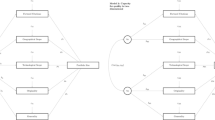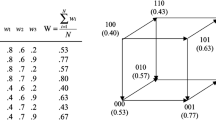Abstract
Star inventors are the most outstanding innovators in the technology field. Most extant literature defines star inventors along the lines of performance and social relationship. This paper presents a three-dimensional model of star inventors—invention performance, social relationship and technology commercialization as an extension of previous multidimensional conceptualizations of individual differences in inventive capacity. Furthermore, a rank–frequency distribution model combined with the Peak Over Threshold (POT) model based on Extreme Value Theory (EVT) is utilized to determine the threshold for distinguishing stars from non-stars. One case study describes inventors in the graphene sector based on the USPTO database. The findings suggest that 491 star inventors can be identified out of 5777 inventors in the graphene sector; the highest overlap between any two types of star inventors is up to 21%. If the commercialization of inventors is not considered, nearly half of the commercial stars will be ignored. All-stars are the most outstanding in terms of invention performance, social relationship and technology commercialization, but they are also the scarcest.







Similar content being viewed by others
References
Abbasi, A., Altmann, J., & Hossain, L. (2011). Identifying the effects of co-authorship networks on the performance of scholars: A correlation and regression analysis of performance measures and social network analysis measures. Journal of Informetrics, 5(4), 594–607.
Agrawal, A., McHale, J., & Oettl, A. (2017). How stars matter: Recruiting and peer effects in evolutionary biology. Research Policy, 46(4), 853–867.
Aguinis, H., & O’Boyle, E. (2014). Star performers in twenty-first century organizations. Personnel Psychology, 67(2), 313–350.
Artz, K. W., Norman, P. M., Hatfield, D. E., et al. (2010). A longitudinal study of the impact of R&D, patents, and product innovation on firm performance. Journal of Product Innovation Management, 27(5), 725–740.
Azoulay, P., Zivin, J. G., & Wang, J. (2010). Superstar extinction. The Quarterly Journal of Economics, 125(2), 549–589.
Balkema, A., & de Haan, L. (1974). Residual life time at great age. The Annals of Probability, 2(5), 792–804.
Bezak, N., Brilly, M., & Sraj, M. (2014). Comparison between the peaks-over-threshold method and the annual maximum method for flood frequency analysis. Hydrological Sciences Journal, 59(5), 959–977.
Blomkvist, K., Kappen, P., & Zander, I. (2014). Superstar inventors—Towards a people-centric perspective on the geography of technological renewal in the multinational corporation. Research Policy, 43(4), 669–682.
Braunerhjelm, P., & Svensson, R. (2010). The inventor’s role: Was Schumpeter right? Journal of Evolutionary Economics, 20(3), 413–444.
Burt, R. S. (1992). Structural holes: The social structure of competition. Harvard University Press.
Call, M., Nyberg, A. J., & Thatcher, S. M. B. (2015). Stargazing: An integrative conceptual review, theoretical reconciliation, and extension for star employee research. Journal of Applied Psychology, 100(3), 623–640.
Caviggioli, F., Colombelli, A., De Marco, A., & Paolucci, E. (2020a). How venture capitalists evaluate young innovative company patent portfolios: Empirical evidence from Europe. International Journal of Entrepreneurial Behaviour and Research, 26(4), 695–721.
Caviggioli, F., De Marco, A., Montobbio, F., & Ughetto, E. (2020b). The licensing and selling of inventions by US universities. Technological Forecasting and Social Change, 159, 120189.
Caviggioli, F., & Forthmann, B. (2022). Reach for the stars: Disentangling quantity and quality of inventors’ productivity in a multifaceted latent variable model. Scientometrics, 127, 7015–7040.
Ernst, H., & Vitt, J. (2000). The influence of corporate acquisitions on the behavior of key inventors. R&D Management, 30(2), 105–120.
Ferrando, P. J., & Lorenzo-Seva, U. (2018). Assessing the quality and appropriateness of factor solutions and factor score estimates in exploratory item factor analysis. Educational and Psychological Measurement, 78(5), 762–780.
Freeman, L. C. (1979). Centrality in social networks: Conceptual clarification. Social Network, 1(3), 215–239.
Grigoriou, K., & Rothaermel, F. T. (2014). Structural micro-foundations of innovation: The role of relational stars. Journal of Management, 40(2), 586–615.
Guan, J. C., & Gao, X. (2009). Exploring the h-index at patent level. Journal of the American Society for Information Science and Technology, 60(1), 35–40.
Guan, J. C., Zuo, K. R., Chen, K. H., & Yam, R. (2016). Does country-level R&D efficiency benefit from the collaboration network structure? Research Policy, 45(4), 770–784.
Hess, A. M., & Rothaermel, F. T. (2011). Star scientists, strategic alliances, and innovation in the pharmaceutical industry. Strategic Management Journal, 32(8), 895–909.
Higham, K., de Rassenfosse, G., & Jaffe, A. (2020). Patent quality: Towards a systematic framework for analysis and measurement. Research Policy, 50(4), 104215.
Hill, B. M. (1975). A simple general approach to inference about the tail of a distribution. The Annals of Statistics, 3(5), 1163–1174.
Hirsch, J. E. (2005). An index to quantify an individual’s scientific research output. Proceedings of the National Academy of Sciences of the United States of America, 102(46), 16569–16572.
Hohberger, J. (2016). Does it pay to stand on the shoulders of giants? An analysis of the inventions of star inventors in the biotechnology sector. Research Policy, 45(3), 682–698.
Jeong, Y., Park, I., & Yoon, B. (2019). Identifying emerging Research and Business Development (R&BD) areas based on topic modeling and visualization with intellectual property right data. Technological Forecasting and Social Change, 146, 655–672.
Kaiser, H. F. (1960). The application of electronic computers to factor analysis. Educational and Psychological Measurement, 20, 141–151.
Kehoe, R. R., Lepak, D. P., & Bentley, F. S. (2018). Let’s call a star a star: Task performance, external status, and exceptional contributors in organizations. Journal of Management, 44(5), 1848–1872.
Kehoe, R. R., & Tzabbar, D. (2015). Lighting the way or stealing the shine? An examination of the duality in star scientists’ effects on firm innovative performance. Strategic Management Journal, 36(5), 709–727.
Khanna, R. (2023). Passing the torch of knowledge: Star death, collaborative ties, and knowledge creation. Research Policy, 52(1), 104649.
Khilji, S. E., Mroczkowski, T., & Bernstein, B. (2006). From invention to innovation: Toward developing an integrated innovation model for biotech firms. Journal of Product Innovation Management, 23(6), 528–540.
Kirchberger, M. A., & Pohl, L. (2016). Technology commercialization: A literature review of success factors and antecedents across different contexts. The Journal of Technology Transfer, 41(5), 1–36.
Klincewicz, K. (2016). The emergent dynamics of a technological research topic: The case of graphene. Scientometrics, 106(1), 319–345.
Kwon, S. (2020). How does patent transfer affect innovation of firms? Technological Forecasting and Social Change, 154(119959), 1–31.
Kwon, S., Porter, A. L., & Youtie, J. (2016). Navigating the innovation trajectories of technology by combining specialization score analyses for publications and patents. Scientometrics, 106(3), 1057–1071.
Lanjouw, J. O., & Schankerman, M. (2004). Patent quality and research productivity: Measuring innovation with multiple indicators. The Economic Journal, 114, 441–465.
Lee, J. (2010). Heterogeneity, brokerage, and innovative performance: Endogenous formation of collaborative inventor networks. Organization Science, 21(4), 804–822.
Liu, F., & Sun, Y. (2009). A comparison of the spatial distribution of innovative activities in China and the U.S. Technological Forecasting and Social Change, 76(6), 797–805.
Liu, H., Mihm, J., & Sosa, M. E. (2018). Where do stars come from? The role of star vs. nonstar collaborators in creative settings. Organization Science, 29(6), 1149–1169.
Liu, K. (2014). Human capital, social collaboration, and patent renewal within U.S. pharmaceutical firms. Journal of Management, 40(2), 616–636.
Lotka, A. J. (1926). The frequency distribution of scientific productivity. Journal of the Washington Academy of Sciences, 16(2), 317–323.
McNeil, A. J., & Zentrum, E. (1997). Estimating the tails of loss severity distributions using extreme value theory. ASTIN Bulletin, 27(1), 117–137.
Moretti, E., & Wilson, D. (2017). The effect of state taxes on the geographical location of top earners: Evidence from star scientists. American Economic Review, 107(7), 1858–1903.
Narin, F., & Breitzman, A. (1995). Inventive productivity. Research Policy, 24(4), 507–519.
Oettl, A. (2012). Reconceptualizing stars: Scientist helpfulness and peer performance. Management Science, 58(6), 1122–1140.
Paruchuri, S. (2010). Intraorganizational networks, interorganizational networks, and the impact of central inventors: A longitudinal study of pharmaceutical firms. Organization Science, 21(1), 63–80.
Piantadosi, S. T. (2014). Zipf’s word frequency law in natural language: A critical review and future directions. Psychonomic Bulletin and Review, 21(5), 1112–1130.
Pickands, J. (1975). Statistical inference using extreme order statistics. The Annals of Probability, 3, 119–131.
Prathap, G. (2018). Eugene Garfield: From the metrics of science to the science of metrics. Scientometrics, 114(2), 637–650.
Pravdic, N., & Oluic-Vukovic, V. (1991). Distribution of scientific productivity: Ambiguities in the assignment of author rank. Scientometrics, 20(1), 131–144.
Rothaermel, F. T., & Hess, D. (2007). Building dynamic capabilities: Innovation driven by individual, firm, and network level effects. Organization Science, 18(6), 898–921.
Schiffauerova, A., & Beaudry, C. (2011). Star scientists and their positions in the Canadian Biotechnology Network. Economics of Innovation and New Technology, 20(4), 343–366.
Schumpeter, J. A. (1934). Theory of economic development. Harvard University Press.
Simonton, D. K. (2004). Creativity in science: Chance, logic, genius, and Zeitgeist. Cambridge University Press.
Simonton, D. K. (2010). Creative thought as blind-variation and selective-retention: Combinatorial models of exceptional creativity. Physics of Life Reviews, 7(2), 156–179.
Srivastava, M. K., & Wang, T. (2015). When does selling make you wiser? Impact of licensing on Chinese firms’ patenting propensity. Journal of Technology Transfer, 40(4), 602–628.
Turkenburg, W. C. (2002). The Innovation Chain: Policies to promote energy innovations, energy for sustainable development (pp. 137–172). The UN Publications.
Tzabbar, D., & Kehoe, R. R. (2014). Can opportunity emerge from disarray? An examination of exploration and exploitation following star scientist turnover. Journal of Management, 40(2), 449–482.
Van Zeebroeck, N. (2011). The puzzle of patent value indicators. Economics of Innovation and New Technology, 20(1), 33–62.
Wang, L., & Li, Z. (2021). Knowledge flows from public science to industrial technologies. The Journal of Technology Transfer, 46(4), 1232–1255.
Xie, X. L. (2017). Analysis of heavy-tailed time series. PhD Thesis, School of the Faculty of Science, University of Copenhagen.
Yang, X., Liu, X., & Song, J. (2019). A study on technology competition of graphene biomedical technology based on patent analysis. Applied Sciences, 9(2613), 1–25.
Yu, H., Zhao, Y., Liu, Z., Liu, W., Zhang, S., Wang, F., Shi, L. (2021). Research on the financing income of supply chains based on an e-commerce platform. Technological Forecasting and Social Change, 169(5), 1–20.
Zacchia, P. (2018). Benefiting colleagues but not the city: Localized effects from the relocation of superstar inventors. Research Policy, 47(5), 992–1005.
Zhu, L., Zhu, D., Wang, X., Cunningham, S., Wang, Z. (2019). An integrated solution for detecting rising technology stars in co-inventor networks. Scientometrics, 121(1), 137–172.
Zucker, L. G., & Darby, M. R. (1996). Star scientists and institutional transformation: Patterns of invention and innovation in the formation of the biotechnology industry. Proceedings of the National Academy of Sciences of USA, 93(23), 12709–12716.
Zucker, L. G., Darby, M. R., & Brewer, M. B. (1998). Intellectual human capital and the birth of U.S. biotechnology enterprises. American Economic Review, 88(1), 290–306.
Funding
This study was supported by National Office for Philosophy and Social Sciences (Grant No. 20&ZD074).
Author information
Authors and Affiliations
Corresponding author
Rights and permissions
Springer Nature or its licensor (e.g. a society or other partner) holds exclusive rights to this article under a publishing agreement with the author(s) or other rightsholder(s); author self-archiving of the accepted manuscript version of this article is solely governed by the terms of such publishing agreement and applicable law.
About this article
Cite this article
Sun, Y., Zhang, Y. & Zhang, X. Reconfiguring star inventors with commercialization: a case of the graphene sector. Scientometrics 128, 5411–5440 (2023). https://doi.org/10.1007/s11192-023-04795-2
Received:
Accepted:
Published:
Issue Date:
DOI: https://doi.org/10.1007/s11192-023-04795-2




